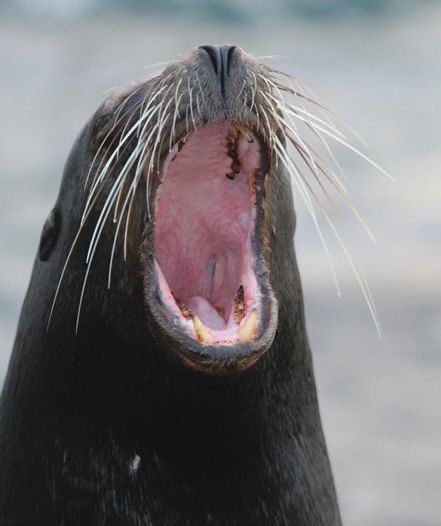Darwinian Tribology
Dr. Martin Webster | TLT President's Report February 2016
The Galápagos Islands show us a unique ecosystem and the fragility of life.

The sea lion is just one of the species naturalists study on the Galápagos Islands, which have been described as an ecological laboratory.
RECENTLY MY WIFE JANET AND I UNDERTOOK AN ECO-TOUR OF THE GALÁPAGOS ISLANDS. This has been on our bucket list for a while, and we were anxious to learn more about the wildlife and ecosystem of this unique archipelago. The islands began to form almost 10 million years ago, created by undersea volcanic eruptions. Subsequent movement of the tectonic plates moved the newly formed islands away from the active volcano site. The repeated process of island formation and tectonic drift, which continues today, eventually resulted in the existing group of islands we see today.
The island’s most famous visitor was Charles Darwin. His famous book, The Origin of the Species, published in 1859, was inspired by some of the observations of the life he found and catalogued during his stay. This work was controversial at the time but eventually formed the basis for the evolutionary biology concepts we know today.
Their isolation from the mainland and the fact that each island represents a different stage in an evolutionary cycle creates a unique series of different environments. Naturalists and biologists still conduct research studies on the Galápagos Islands, which have been described as an ecological laboratory. In learning more about how the evolutionary process has worked on these islands, I began to realize that parallels exist in the formation and evolution of our own discipline.
Since they have never been connected to the mainland, life on the islands gained its start by life forms that were transported by wind, ocean currents or carried by visiting sea birds and animals. Likewise when the term
tribology was first used to unify our disparate disciplines, existing ideas and concepts were transported from the worlds of engineering, physics, chemistry and materials science.
Over time, new islands have been created to add to the original archipelago. Likewise, we have seen new tribological islands created that have added to the original classical topics. A great example is the emergence of nanotribology, which is now providing us with a mechanistic understanding of friction and wear processes at the molecular level. Furthermore, like the final fate of a Galápagos Island that ends up being eroded below sea level, we have seen waning interest in some hitherto topical areas. An example would be research into the tribology of magnetic recording media that had its heyday more than a decade ago.
Evolutionary forces have created diversity even among a single species. The Galápagos Islands are home to 13 different subspecies of birds that are often referred to as Darwin’s Finches. The variations can be recognized by looking at something as simple as the beaks, which range in size and shape from being blunt and well suited to crushing seeds to sharp needle-shaped versions that are adapted toward probing for food sources. The changes are driven by external environmental factors and can be imperceptibly gradual between the different sub-species.
In our tribological world, a group of experts might have a common interest, but their individual expertise may be honed to solve specific problems. Taking our nanotribology example, individuals may focus on either a theoretical approach using such tools as molecular dynamics simulations or a more experimental approach using nano-tools such as the atomic force microscope. Combinations between these approaches produce a continuum of specializations much like Darwin’s Finches.
Our visit to the Galápagos Islands coincided with an El Niño year in which the cool Humboldt Current is replaced by a warmer Equatorial Current. The changes in sea temperature influence local and global weather patterns. Crucially, it also disrupts the distribution of nutrients associated with the Humboldt Current and has a dramatic effect on the entire Galápagos food chain.
Lack of food forces some animals to produce fewer offspring in El Niño years while other groups are less affected. Even at the early stage of this year’s El Niño, we witnessed albatross eggs and even sea lion pups that had been abandoned. In our tribological archipelago, lean economic times reduced funding sources from government and industry can force some hard decisions. Some activities such as work toward meeting global fuel economy and emission standards might be maintained while other programs are delayed until funding returns at a later date.
The chance to visit the unique ecosystem that exists on the Galápagos Islands has left Janet and me with a renewed appreciation for the fragility of the life that exists there. Happily, Ecuador and naturalists around the world have recognized the need to maintain the environment and natural resources on the islands. Tours such as ours are limited and are well managed in order to limit their impact. Visitors to the islands are encouraged to be ambassadors for the wildlife that inhabits the islands to make sure they remain preserved for future generations.
Similarly, through various advocacy efforts, STLE is striving to improve the public perception of how important lubrication and tribology are to human existence both socially and economically. Each of us should consider ourselves as ambassadors to carry the message at every opportunity.
 Martin Webster is a senior research associate for ExxonMobil Research and Engineering in Annandale, N.J. You can reach him at martin.n.webster@exxonmobil.com
Martin Webster is a senior research associate for ExxonMobil Research and Engineering in Annandale, N.J. You can reach him at martin.n.webster@exxonmobil.com.